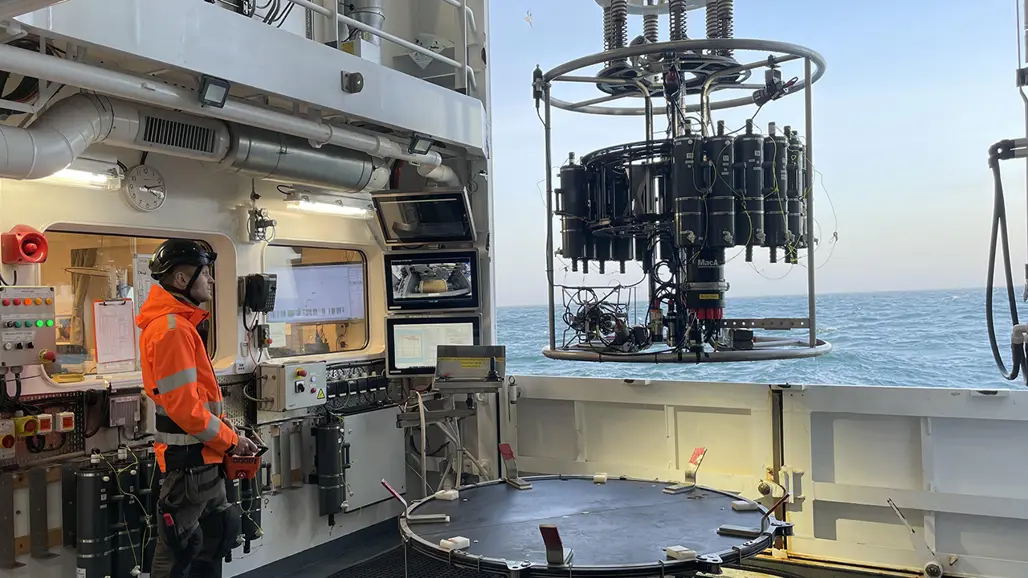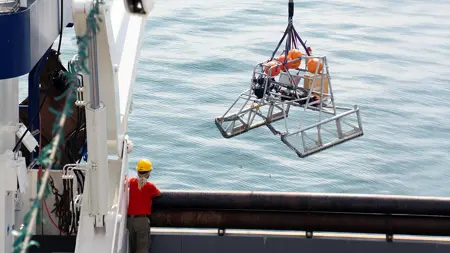
Scientific equipment
Whether the mission involves research, environmental monitoring or mapping, R/V Svea has the capacity required. The vessel is equipped with advanced sensors, instruments, and purpose-built platforms.
Onboard tools and systems
Svea’s primary CTD system is a custom-designed rosette sampler equipped with water bottles and advanced sensors, providing high-resolution data on the physical and chemical properties of the water column. The system is lowered into the water and records measurements in real time while collecting water samples at selected depths.
Please note: Not all laboratory equipment is part of the vessel’s standard instrumentation. Some equipment belongs to SMHI and is only available upon special agreement. Please contact us well in advance of your expedition.
Function and equipment:
- CTD unit (Conductivity, Temperature, Depth): Measures conductivity, temperature, and pressure with high accuracy. From these, salinity, density, depth, and sound velocity are calculated.
- 24 water sampling bottles (5 litres each): Mounted in a cylindrical frame and used to collect water from specific depths in the water column.
- Sensors: Measure parameters such as dissolved oxygen, chlorophyll-a and phycocyanin fluorescence, PAR (Photosynthetically Active Radiation), and turbidity.
- Fibre-optic data transmission: Real-time transfer of sensor data and video from an underwater camera.
- Integrated winch with Active Heave Compensation: Ensures smooth and precise sampling even in rough sea conditions.
- Onboard software: For data processing and quality control.
In addition to the main rosette system, a smaller, portable CTD unit is also available on board – a Sea-Bird SBE 19plus. This is used for simpler or quicker measurements, for example in shallow waters or from the work boat.
Function and equipment:
- Sensor system for salinity, temperature, and depth.
- Optional add-on sensors for oxygen, fluorescence, etc.
- Internal datalogger that stores all measurements during deployment.
The MVP system (Moving Vessel Profiler) allows for continuous collection of CTD data while the vessel is underway, without the need to stop. On board R/V Svea, an MVP200 unit is used, equipped with a sensor package that provides real-time water column profiles – even at cruising speed.
Function and equipment:
- Self-operating winch system that automatically deploys and retrieves the profiling probe while the vessel is moving
- Operates at speeds of up to 10–11 knots
- Equipped with sensors for temperature, salinity, dissolved oxygen, chlorophyll, and turbidity
- Profiles to depths of approximately 300 metres (depending on speed and bottom topography)
- Fully integrated into the vessel’s data network for real-time monitoring and data storage
Svea’s FerryBox system is an automated flow-through system that continuously collects and analyses surface water (~5 m depth) while the vessel is underway. The FerryBox enables large-scale marine monitoring, both geographically and over time, as measurements and sampling can be carried out uninterrupted for extended periods.
Parameters recorded include temperature, salinity, and oxygen levels. pH and carbon dioxide are measured for ocean acidification studies, while chlorophyll and phycocyanin fluorescence are monitored to detect algal activity, including cyanobacterial blooms.
Function and equipment:
- Sensors for temperature, salinity, and oxygen.
- Bio-optical sensors for measuring chlorophyll, phycocyanin, CDOM (coloured dissolved organic matter), and turbidity (particle density).
- Instruments for pH and carbon dioxide (pCO₂).
- Data are logged and stored in real time, linked to GPS position.
- The system is integrated with the vessel’s data network for immediate access and analysis.
The Imaging FlowCytobot (IFCB) is an advanced instrument that combines flow cytometry with imaging to identify and quantify plankton in water samples. Onboard Svea, the IFCB is integrated with the FerryBox system for continuous sampling and analysis.
Function and equipment:
- Automated collection of water samples every 20 minutes via the FerryBox.
- High-resolution images of plankton captured in real time.
- Laser-induced fluorescence and light scattering used to detect and image particles.
R/V Svea is equipped with two fixed Acoustic Doppler Current Profilers (ADCPs) that measure ocean currents throughout the entire water column. These instruments record both the speed and direction of water movement – from the surface down to significant depths.
Function and equipment:
- Two ADCPs mounted in the drop keel:
- 150 kHz unit for deeper waters Teledyne Marine: Ocean Surveyor ADCP
- 600 kHz unit for high-resolution measurements near the surface, Teledyne Marine: Workhorse Mariner ADCP - Simultaneous multi-layer measurements, with continuous data collection while underway
- Fully integrated into Svea’s onboard data storage system
R/V Svea is equipped with a comprehensive suite of acoustic instruments from Kongsberg Simrad. Several of the echosounders are mounted in one of the vessel’s two drop keels, allowing them to be lowered below the turbulent zone of the hull. This results in cleaner data and clearer signals. Together, these systems provide highly detailed information on seafloor structures, water masses, and fish – making Svea an outstanding platform for research requiring high-precision acoustic measurements
- Scientific echosounder – EK80
A broadband echosounder system used to study fish, plankton, and other organisms in the water column. The EK80 combines multiple frequencies (10–500 kHz), allowing researchers to distinguish between different organisms in real time. Installed in both the drop keel and on the towed underwater platform Focus-2. - Multibeam echosounder – EM2040)
A multibeam echosounder providing detailed images of the seafloor, including depth, bottom structures, and underwater objects. The EM2040 is particularly useful for geological surveys, structure searches (e.g. shipwrecks), and habitat mapping. - Multibeam sonar – MS70
An acoustic instrument that measures echoes perpendicular to Svea’s drop keel. The MS70 provides quantitative data that can be used to estimate the biomass of pelagic fish schools. - Multibeam echosounder – ME70
Used in fisheries surveys. It covers a wide swath beneath the vessel and provides quantitative data that can be used to estimate the biomass of pelagic fish. - Sub-bottom profiler – TOPAS PS40
A low-frequency penetrating echosounder used to map sediment layers beneath the seabed. The TOPAS PS40 provides detailed cross-sectional images of geological structures. - Fish sonars – SX90 och SH90
- SX90 is used to detect fish schools at long range – particularly useful before trawling.
- SH90 delivers high-resolution images of nearby fish schools, with real-time tracking of their movement. - Acoustic Positioning – HiPAP
A precision system used to track underwater equipment such as remotely operated vehicles (ROVs) or sensors. Using acoustic signals, the system enables accurate positioning even in deep water.
R/V Svea is equipped with two different remotely operated towed vehicles (ROTVs) from MacArtney. These platforms enable the collection of high-resolution data near the seabed or throughout the water column – without requiring the vessel to stop.
Models och functions
- Triaxus
An undulating platform used to collect very high-resolution CTD data. While the vessel is underway, Triaxus automatically moves up and down through the water column and can profile from approximately 1 to 350 metres. It is equipped with a range of sensors, including salinity, temperature, oxygen, turbidity, and chlorophyll. - Focus 2
A platform used for acoustic surveys of fish and plankton, equipped with the Simrad EK80 echosounder (10–500 kHz).
Depth data from the ROTVs are used as input for motion compensation systems from Scantrol.
R/V Svea is equipped with a custom-built sledge carrying an underwater video camera.
The system is used to document and monitor benthic species and their habitats in a gentle and efficient manner. The camera rig is fitted with fixed-width laser markers, enabling the collection of quantitative data as the vessel moves slowly along a transect across the seafloor.

R/V Svea is equipped with the technical infrastructure required to operate remotely operated vehicles (ROVs) and can support both small and medium-sized systems.
Research projects using their own ROVs are already welcome to bring equipment on board, and the vessel is designed to allow smooth integration of external systems. In the near future, Svea will also acquire its own ROV, a strategic investment that will further strengthen the vessel’s capabilities.
Unlike many other research vessels, R/V Svea is purpose-built for scientific trawling. The vessel is fully equipped to conduct both bottom and pelagic trawling in a safe and efficient manner.
Please note. Trawl gear is not part of the vessel’s standard equipment. It is provided by SLU Aqua (the Department of Aquatic Resources) and may only be used by special agreement. Please contact us well in advance if your expedition includes trawling operations.
Trawl gear available through SLU Aqua:
- GOV trawl (Grand Ouverture Vertical) – standard bottom trawl used in stock assessments in the Skagerrak and Kattegat.
- TV3 trawl – standard bottom trawl used in stock assessments in the Baltic Sea.
- Two Gloria-Helix pelagic trawls of different sizes – used for trawling in the open water column (pelagic trawling).
All trawls are operated using iSYM Autotrawl från Scantrol - an advanced control system that ensures precise management of trawl geometry while underway. The system allows fine-tuning of trawl opening, position, and towing force, enhancing the accuracy of both sampling and data analysis.
Trawl monitoring is supported by Simrad (Kongsberg) TV80 sensors, which provide detailed information on the horizontal and vertical opening of the trawl, the distance between trawl doors, trawl depth, and water flow through the gear.
R/V Svea is equipped with a modern, integrated data management system. At the core of this system is ther MDM500 from Kongsberg Maritime, which continuously collects and stores data from a wide range of sources – including echosounders, meteorological instruments, CTD systems, water analysis equipment, and positioning systems.
All data is precisely time-synchronised, and measurements can be monitored in real time from multiple workstations throughout the vessel.
To enable long-term storage of samples, R/V Svea is equipped with freezers capable of reaching temperatures as low as –90 °C. This allows sensitive material to be frozen immediately after sampling and preserved throughout the expedition for further analysis on shore.
Contact
-
PersonMattias Sköld, researcherInstitute of Marine Research, joint staff